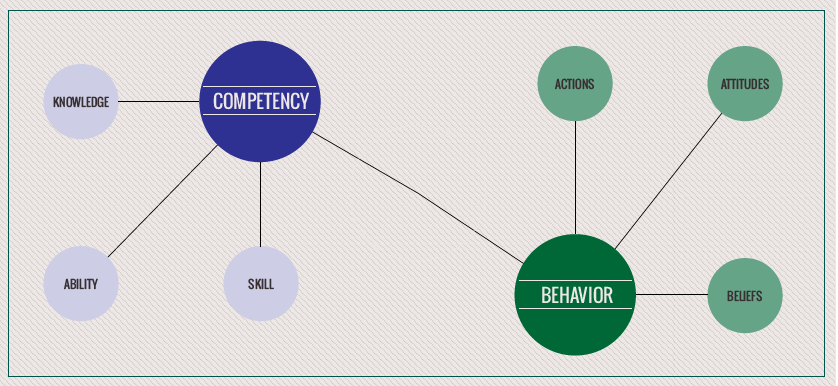What is the difference between competencies and behaviors when establishing performance criteria?
Competencies and behaviors are different concepts, yet one can influence the other and vice-versa. However, they are to be analyzed separately when they represent decisional factors for an employee’s performance.
A competency is comprised of three main dimensions:
- The first dimension is aptitude, also identifiable under the name of ability, which consists in a person’s internal potential to accomplish one or more activities, in a certain manner and at a certain level of quality. The presence of an aptitude represents the employee’s predisposition to successfully perform specific requirements or tasks. Aptitudes are an inner characteristic. People are born with them and they can have very little influence upon these features. An aptitude can be grown from a minimal level to a higher one, but cannot be developed in situations where there is a complete incapacity to deploy or to perform a certain function. Therefore, in order to speculate one’s competency, or to develop it in an employee context, it is necessary to firstly identify the ability that leads to that competency.
- Secondly, in order to build up a competency, one must consider knowledge as a dimension that ads up. Through knowledge, employees assimilate and understand all the theoretical information related to performing a certain task or activity. Knowledge can be a dimension previously developed through formal or self-directed study. Also, depending on what performing the activity entails and requires, the knowledge dimension can very well be developed on the spot in order to reach a competency. Taking this into consideration, when evaluating a specific competency for employees, it must be clearly stated if the required knowledge is something that can be assimilated in a short period of time, and therefore is not prerequisite, or it requires a long time to be assimilated. Compared to aptitudes, knowledge is a dimension that can be built or developed, irrespective of the previous knowledge levels. Also, in an organizational context, employees can be involved in knowledge development programs such as courses, workshops or studies.
- The last dimension that comes to complete a competency is skill, which relies on the employees’ developed dexterity to perform and accomplish an activity or a task, at a certain level with a certain speed. Skills ca be developed in time, through exercises and practice, as they reveal one’s handiness to perform.
Behaviors also are built on three main dimensions:
- The first dimension is expressed by one’s inner beliefs regarding the outside environment. Beliefs are more than opinions, they represent certitudes developed in time. Belief systems are built and developed upon the existing culture and core values. Employees with personal values similar to the company’s find it easier to integrate themselves within the organization and behave according to organizational culture.
- Beliefs determine attitudes, which represent the second dimension that leads to developing a certain behavior. An attitude is an indirect form of manifestation, which implies adopting a position towards something or someone without an explicit expression. Employees with good emotional management can maintain or modify their attitudes, without them becoming a hindrance for their organizational conduct.
- Action represents the third behavioral dimension through which employees will manifest themselves, displaying both beliefs and attitudes. In particular cases, like intense experiences, actions can be entirely dictated by a momentary belief. In order to predict employee behavior it is necessary for the company to have good knowledge of their beliefs and reactions to extreme situations.
When selecting criteria for employee performance, competencies and behaviors are to be considered separately and interpreted accordingly. Often enough, the appropriate job aptitudes can be accompanied by the wrong attitudes. These aspects predict that a person can have the right competency to accomplish job tasks, but will not do it in the right manner, or according to the company’s policies or organizational culture.
Another crucial difference here is the fact that these elements have different potentials for change or development. For example, competencies are more likely to be developed, increased or changed, rather than behaviors.
Alexandra Blaga. Organizational Development Specialist. The KPI Institute

Tags: Ask the Experts, Human Resources performance, Performance Management






